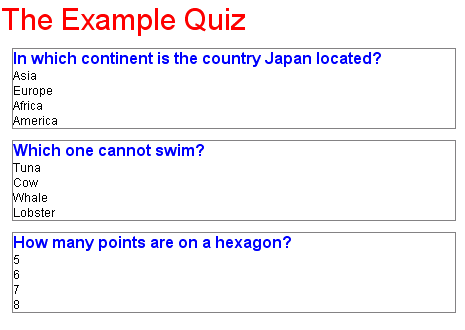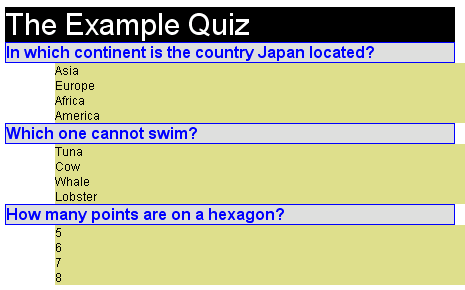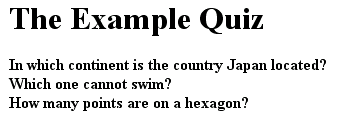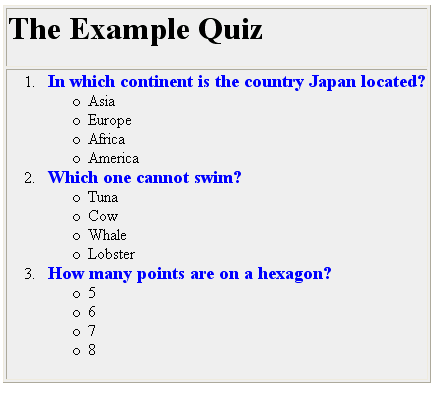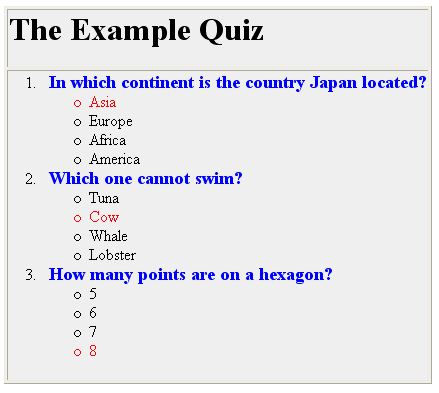
AN XML CASE STUDY
EXAMPLE SCHEMA
Rules:
- Root element is <quiz>.
- <quiz> contains a <title> and an <items> element.
- <items> contains one or more <item> element.
- <item> contains one <question>, at least 2 <answer>s, and no more than 6 <answer>s.
- One of the answer must have an attribute "correct=y" which indicates the correct answer.
- <question> might appear before of after all the <answer>s.
<?xml version="1.0"?> <quiz> <title>The Example Quiz</title> <items> <item> <question>In which continent is the country Japan located?</question> <answer correct="y">Asia</answer> <answer>Europe</answer> <answer>Africa</answer> <answer>America</answer> </item> <item> <answer>Tuna</answer> <answer correct="y">Cow</answer> <answer>Whale</answer> <answer>Lobster</answer> <question>Which one cannot swim?</question> </item> <item> <question>How many points are on a hexagon?</question> <answer>5</answer> <answer>6</answer> <answer>7</answer> <answer correct="y">8</answer> </item> </items> </quiz>
- A DTD declaration for that XML spec:
Problems:
- Hard to limit the number of <answer>s to 6 maximum. One way will be to declare it like:
<!ELEMENT item (question, ((answer, answer)|
(answer, answer, answer)|
(answer, answer, answer, answer)|
(answer, answer, answer, answer, answer)|
(answer, answer, answer, answer,answer,answer)))>
but do you want to?
Even with that, you still have to handle the requirement where <question> might appear after the <answer>s, so it will be:
<!ELEMENT item ((question, ((answer, answer)|
(answer, answer, answer)|
(answer, answer, answer, answer)|
(answer, answer, answer, answer, answer)|
(answer, answer, answer, answer,answer,answer)))|
(((answer, answer)|
(answer, answer, answer)|
(answer, answer, answer, answer)|
(answer, answer, answer, answer, answer)|
(answer, answer, answer, answer, answer, answer)), question))>- The DTD does not limit the number of <answer>s that has the "correct" attribute. So there might be an <item> with 2 or more correct answers. Can this be solved without changing the structure of the XML? Probably not.
- Create a Schema declaration for that XML spec:
Attempt 1:
<?xml version="1.0"?> <xsd:schema xmlns:xsd="http://www.w3.org/2001/XMLSchema"> <xsd:element name="title" type="xsd:string"/> <xsd:element name="question" type="xsd:string"/> <xsd:element name="answer"> <xsd:complexType> <xsd:simpleContent> <xsd:extension base="xsd:string"> <xsd:attribute name="correct" type="xsd:string"/> </xsd:extension> </xsd:simpleContent> </xsd:complexType> </xsd:element> <xsd:complexType name="itemType"> <xsd:sequence> <xsd:element ref="question"/> <xsd:element ref="answer" minOccurs="2" maxOccurs="6"/> </xsd:sequence> </xsd:complexType> <xsd:element name="item" type="itemType"/> <xsd:complexType name="itemsType"> <xsd:sequence> <xsd:element ref="item" minOccurs="1" maxOccurs="unbounded"/> </xsd:sequence> </xsd:complexType> <xsd:element name="items" type="itemsType"/> <xsd:element name="quiz"> <xsd:complexType> <xsd:sequence> <xsd:element ref="title" minOccurs="1" maxOccurs="1"/> <xsd:element ref="items" minOccurs="1" maxOccurs="1"/> </xsd:sequence> </xsd:complexType> </xsd:element> </xsd:schema>Problems:
Attempt 2:
- <question> must appear before <answer>s in this schema because it's declared in <xsd:sequence>.
- The <answer> attribute "correct" can be assigned any values, while we only want to accept "y".
- This schema allows more than 1 correct <answer>s. Again, it might not be possible to create a schema which prevents this.
<?xml version="1.0"?> <xsd:schema xmlns:xsd="http://www.w3.org/2001/XMLSchema"> <xsd:element name="title" type="xsd:string"/> <xsd:element name="question" type="xsd:string"/> <xsd:simpleType name="correctType"> <xsd:restriction base="xsd:string"> <xsd:enumeration value="y"/> </xsd:restriction> </xsd:simpleType> <xsd:element name="answer"> <xsd:complexType> <xsd:simpleContent> <xsd:extension base="xsd:string"> <xsd:attribute name="correct" type="correctType"/> </xsd:extension> </xsd:simpleContent> </xsd:complexType> </xsd:element> <xsd:element name="item"> <xsd:complexType> <xsd:choice> <xsd:sequence> <xsd:element ref="question"/> <xsd:element ref="answer" minOccurs="2" maxOccurs="6"/> </xsd:sequence> <xsd:sequence> <xsd:element ref="answer" minOccurs="2" maxOccurs="6"/> <xsd:element ref="question"/> </xsd:sequence> </xsd:choice> </xsd:complexType> </xsd:element> <xsd:element name="items"> <xsd:complexType> <xsd:sequence> <xsd:element ref="item" minOccurs="1" maxOccurs="unbounded"/> </xsd:sequence> </xsd:complexType> </xsd:element> <xsd:element name="quiz"> <xsd:complexType> <xsd:sequence> <xsd:element ref="title" minOccurs="1" maxOccurs="1"/> <xsd:element ref="items" minOccurs="1" maxOccurs="1"/> </xsd:sequence> </xsd:complexType> </xsd:element> </xsd:schema>
This schema is much cleaner that before. We used a lot of unnamed types because we don't need to reuse the types. "correctType" is a type that contains only 1 valid value, which is "y". The <item> element is declared within <xsd:choice> to allow <question> to appear before or after the <answer>s.Problems:
- This schema allows more than 1 correct <answer>s.
DISPLAYING THE XML DATA
Displaying data using CSS style sheet.
- Style sheet example 1
title { font-family:helvetica;font-size: 30px;display:block;color:red; } items { display: block;font-family:helvetica;font-size: 12px;color: black; } item { display: block;border:1px solid gray;margin: 3mm;font-family:helvetica; font-size: 12px;color: black; } question { display: block;font-family:helvetica;font-size: 16px; font-weight: bold;color: blue; } answer { display: block;font-family:helvetica;font-size: 12px;color: black; }
Result on IE6:
- Style sheet example 2
title { font-family:helvetica; font-size: 30px; display:block; color:white; background:rgb(0,0,0); } items { bacgkround:#DDDDDD; display: block; font-family:helvetica; font-size: 12px; color: black; } item { display: block; margin: 0mm; font-family:helvetica; font-size: 12px; color: black; } question { display: block; font-family:helvetica; font-size: 16px; font-weight: bold; color: blue; position: relative; background:#DDDDDD; border: solid 1px; } answer { display: block; position:relative; left:50px; font-family:helvetica; font-size: 12px; color: black; background:#DDDD88; }Result on IE6:
- Style sheet 3 (show questions only)
The answer element style is set to visibility: hidden.
title { font-family:helvetica; font-size: 30px; display:block; color:white; background:rgb(0,0,0); } item { display: block; font-family:helvetica; font-size: 12px; color: black; } question { display: block; font-family:helvetica; font-size: 16px; color: black; } answer { visibility: hidden; }Displaying Data Using XSLT.
- Hides answers: example 1
<?xml version="1.0"?> <quiz:stylesheet xmlns:quiz="http://www.w3.org/1999/XSL/Transform" version="1.0"> <quiz:template match="/"> <html> <head><title>Quiz Example formatted with XSLT</title></head> <body> <quiz:apply-templates /> </body> </html> </quiz:template> <quiz:template match="title"> <H1><quiz:value-of select="."/></H1> </quiz:template> <quiz:template match="answer"> </quiz:template> <quiz:template match="question"> <b><quiz:value-of select="."/></b><br/> </quiz:template> </quiz:stylesheet>What that does:
- Add bullet on every answer:: example 2
<?xml version="1.0"?> <quiz:stylesheet xmlns:quiz="http://www.w3.org/1999/XSL/Transform" version="1.0"> <quiz:template match="/"> <html> <head><title>Quiz Example formatted with XSLT</title></head> <body> <table border="1" bgcolor="#EEEEEE"> <quiz:apply-templates/> </table> </body> </html> </quiz:template> <quiz:template match="title"> <tr><td><H1><quiz:value-of select="."/></H1></td></tr> </quiz:template> <!-- each item is put inside a cell table, --> <!-- an "item" is numbered using ordered list OL--> <quiz:template match="items"> <tr><td><ol><quiz:apply-templates/></ol></td></tr> </quiz:template> <quiz:template match="item"> <LI><b><font size="4" color="0000FF"> <quiz:value-of select="question"/></font></b></LI><br/> <!-- loop answers and apply bullet for each answer--> <UL> <quiz:for-each select="answer"> <LI><quiz:value-of select="."/></LI> </quiz:for-each> </UL> </quiz:template> </quiz:stylesheet>What that does:
- Creates a table within the body of the html.
- <title> is printed inside a table cell as <H1>.
- To put a number for each item, <items> mark a beginning of an ordered list <OL>.
- A <question> is a list item <LI> of the ordered list <OL>. This causes the number to be printed.
- Each answer is marked as a list item <LI> of a nested unordered list <UL>, this produces the bullets.
- Show correct answer in different color: example 3
<?xml version="1.0"?> <quiz:stylesheet xmlns:quiz="http://www.w3.org/1999/XSL/Transform" version="1.0"> <quiz:template match="/"> <html> <head><title>Quiz Example formatted with XSLT</title></head> <body><table border="1" bgcolor="#EEEEEE"> <quiz:apply-templates/></table> </body> </html> </quiz:template> <quiz:template match="title"> <tr><td><H1><quiz:value-of select="."/></H1></td></tr> </quiz:template> <!-- is numbered using ordered list OL--> <quiz:template match="items"> <tr><td><ol><quiz:apply-templates/></ol></td></tr> </quiz:template> <quiz:template match="item"> <LI><b><font size="4" color="0000FF"> <quiz:value-of select="question"/></font></b></LI><br/> <!-- loop answers and apply bullet for each answer--> <UL> <quiz:for-each select="answer"> <!-- display correct answer in different style--> <quiz:choose> <quiz:when test="@correct='y'"> <font color="red"><LI><quiz:value-of select="."/></LI></font> </quiz:when> <!-- Comment out the otherwise below to just show the --> <!-- correct answer.--> <!-- below is a different way to apply --> <!-- the template to the "answer" node--> <!-- It selects the node first, then applies the templaye --> <!-- the "when" above can also call the same apply template --> <!-- instead of writing out the code again--> <quiz:otherwise> <quiz:apply-templates select="." /> </quiz:otherwise> </quiz:choose> </quiz:for-each> </UL> </quiz:template> <quiz:template match="answer"> <li><quiz:value-of select="."/></li> </quiz:template> </quiz:stylesheet>This XSLT is almost identical to the one above, except this one check the attribute of the <answer> element and prints the <answer> with attribute correct="y" in different color. It uses <choose> and <when> tests to check the attributes.
- Show correct answer only: example 4
<?xml version="1.0"?> <quiz:stylesheet xmlns:quiz="http://www.w3.org/1999/XSL/Transform" version="1.0"> <quiz:template match="/"> <html> <head><title>Quiz Example formatted with XSLT</title></head> <font face="Arial,helvetica, verdana"> <body> <table border="1" bgcolor="#EEEEEE"> <quiz:apply-templates/> </table> </body> </font> </html> </quiz:template> <quiz:template match="title"> <tr><td><H1><quiz:value-of select="."/></H1></td></tr> </quiz:template> <quiz:template match="items"> <quiz:apply-templates/> </quiz:template> <quiz:template match="item"> <b><font size="3" color="0088FF"> <quiz:value-of select="question"/></font></b></LI> <!-- loop answers and apply bullet for each answer--> <TR><TD> <UL> <quiz:for-each select="answer"> <!-- display correct answer in different style--> <quiz:choose> <quiz:when test="@correct='y'"> <font color="black"><LI> <quiz:value-of select="."/></LI> </font> </quiz:when> </quiz:choose> </quiz:for-each> </UL> </TD></TR> </quiz:template> </quiz:stylesheet>This XSLT is almost identical to the one above, except this one ignores any <answer> that does not have the attribute correct="y"; and also, this one puts each <item> inside a table cell.
Result on IE6:
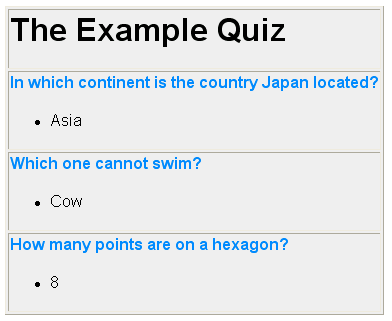
- Showing answer, then question: example 5
<?xml version="1.0"?> <quiz:stylesheet xmlns:quiz="http://www.w3.org/1999/XSL/Transform" version="1.0"> <quiz:template match="/"> <html> <head><title>Quiz Example formatted with XSLT</title></head> <body><quiz:apply-templates/></body> </html> </quiz:template> <quiz:template match="title"> </quiz:template> <quiz:template match="item"> <quiz:for-each select="answer"> <quiz:choose> <quiz:when test="@correct='y'"> <P/><font color="black"><B> <quiz:value-of select="."/></B> is the correct answer for: </font> <font color="red"> <I><quiz:value-of select="../question"/></I> </font> </quiz:when> </quiz:choose> </quiz:for-each> </quiz:template> </quiz:stylesheet>This XSLT ignores the <title> element. It then selects and prints the correct answer. Following that, it uses XPath to find the <question> and prints the question.
<<INDEX>>
(C) 2002 F. Permadi
